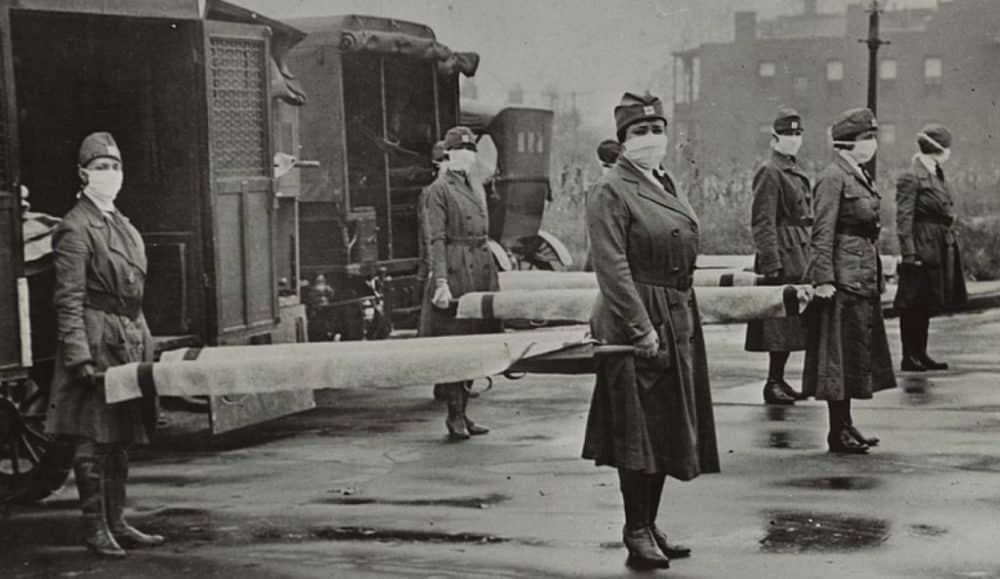With everything that’s going on with Coronavirus as it nears pandemic status, it seems only fitting that we take a gander at some of the most devastating pandemics that the world has seen over the centuries. Hopefully it will make us feel better, as these are way worse than Coronavirus.
Featured Image VIA
A pandemic is an outbreak of a disease that spreads world-wide as opposed to an epidemic where the disease is generally contained to one part of the world. Millions of people have been wiped out as a result of uncontrollable viruses and diseases running riot and even today with our modern medicine and containment procedures, we remain vulnerable to pandemics as we can unfortunately see right now.
So let’s take a look and see how some past outbreaks compare to Coronavirus and let’s hope it doesn’t reach the scale of some of these. Fingers crossed.
1. The Third Cholera Pandemic

Image VIA
There have been a total of seven cholera pandemics throughout history and it’s the third of these which is generally considered to be the most deadly. Appearing in 1852 and continuing until 1860, cholera spread from India and across the Ganges before ripping through Asia, Europe, North America and Africa like wildfire.
Cholera is a disease caused by bacteria that produces watery diarrhea and dehydration and still causes concerns today. The disease can be deadly for those with pre-existing health issues or for those who are not replenished with fluid treatments promptly.
It turned out cholera is transmitted via contaminated water and we have London physician John Snow to thank for this discovery after he studied the outbreak in the Soho district of London. This was discovered in 1854 – coincidentally this was also the worst year of the pandemic, with 23,000 people dying in Great Britain alone.
2. HIV/AIDs

Image VIA
The HIV/AIDs pandemic is one which we are still fighting. Fortunately, due to advances with medicine the disease is no longer a death sentence and can usually be managed along with other chronic conditions.
Originating in Cameroon and first identified in the Congo in 1959, HIV/AIDs has killed more than 36 million people across the globe since 1981. Estimates suggest some 31-35 million people are living with HIV, including 5% of the population in Sub-Saharan Africa.
Initial symptoms of HIV take the form of a flu-like sickness soon after contracting the illness. Following this, a person will test positive for the virus and HIV will slowly weaken the immune system over time and further symptoms such as weight loss, night sweats, diarrhoea and tiredness may appear over time.
And something I didn’t know before writing this piece is that once someone is on effective treatment and the viral load becomes undetectable, HIV cannot be passed on. Guess we’re slowly winning the war against this one – it’s a shame HIV has the stigma it does, but fortunately we have come a long way with treatment options and those infected can live relatively normal lives.
3. The Black Death

Image VIA
Just saying “The Plague” is enough to conjure up images of pus-seeping boils and beak-nosed plague doctors, such is the idea of it so ingrained into our heads through numerous TV shows, films and documentaries featuring it.
For those of you that don’t know, the bubonic plague is a serious bacterial infection that ravaged the world during medieval times and still affects 1,000-2,000 people each year, predominantly in African countries. From 1346 and 1353, the Black Death devastated Europe, Africa and Asia with an estimated death toll pitched between 75 and 200 million people, effectively wiping out half of Europe.
Rapidly progressing and propelled by poor sanitation and overcrowding, the bubonic plague is usually transmitted to humans through fleas. Thought to have originated in Asia, merchant ships were likely responsible for its quick escalation due to the fleas living on the rats aboard these ships.
The plague is one of the more terrifying diseases on this list as it is life-threatening and requires urgent care, with death occurring within 24 hours if left untreated. Symptoms of bubonic plague include fever and chills, headache, muscle pain, weakness and seizures.
Lest we forget the most iconic symptom thoughL pus-filled black boils known as buboes – hence the name bubonic plague. Buboes are swollen lymph glands and typically appear in the groin, armpits and neck and can grow to the size of an apple. I remember being taught in school how these would eventually burst and send pus spurting all over the place, spreading the disease further. Revolting.
The Black Death is a particularly savage disease and one pandemic that the world will hopefully never see again. Way worse that Coronavirus.
4. The Antonine Plague

Image VIA
An unknown disease thought to be either smallpox or measles was brought back by Roman soldiers returning from Mesopotamia (modern-day Iraq) around 165 AD. The disease decimated the Roman army and killed up to 5 million people in Asia, Egypt, Greece and Italy. These are crazy high numbers when you consider the world population was around just 200 million at the time.
Named after Emperor Marcus Aurelius Antoninus who ruled during the outbreak, the pandemic lasted until 180 AD. It is estimated that at its peak, some 2,000 Romans died each day, including the aforementioned Emperor.
Smallpox and measles are relatively uncommon today but this is a prime example of where a lack of understanding and knowledge has led to devastation as we’ve struggled to understand containment and prevention. Thankfully we’re a lot further advanced in our medicine these days – although whether we manage to contain the Coronavirus is anyone’s guess.
5. Spanish Flu

Image VIA
There have been a handful of flu pandemics throughout the years and between 1918 and 1920, a particularly deadly influenza outbreak spread across the globe. It was dubbed the Spanish Flu because it received greater press attention after it moved from France to Spain, although the Spanish weren’t too fond of the name as the illness didn’t even originate in Spain.
The pandemic resulted in over a third of the world’s population becoming infected and killed -between 20 and 50 million people. Think about that for a moment: we currently have a global population of around 7.7 billion people so if one third of today’s world became infected, that would be around 2.5 billion people infected. Sheesh.
What made this flu pandemic so scary was the fact that this influenza was indiscriminate. It killed not only children, the elderly and those with weakened health, but also completely healthy adults who you would have thought might have been able to beat it.
The mortality rate was worryingly high at 10%-20% and wasn’t helped by troops living in close quarters fighting during World War 1. Again, a much more deadly pandemic that Coronavirus in this respect.
———————————————————————————————————————-
We can wage wars and drop bombs, but ultimately, mother nature packs the biggest weapons. All it takes is one simple mutation for a virus to jump from animal to human or to evolve from faecal-oral to airborne transmission and we’re screwed. We must then try and catch up and figure these viruses out before we experience the ramifications.
Coronavirus has caused international alarm but it is important we remain realistic and logical regarding the epidemic. Yes ,it is scary and the media doesn’t help with the mass hysteria, but often viruses that spread easily tend to have a milder impact. Coronavirus is hitting older people hardest and those with weakened immune systems, so it seems unlikely that half the world’s population is going to be wiped out or anything like that.
To put it into perspective, SARS (also a type of coronavirus) had a mortality rate of over 10% and so in the grand scheme of things, this coronavirus is nowhere near as deadly. It currently has an estimated 1-2% mortality rate, so we really don’t need to be diving into the bunkers just yet.
Obviously, if you do think you have contracted coronavirus and experience symptoms such as fever, coughing and difficulty breathing, follow the relevant public health advice available at the time. You should be just fine.
For more on coronavirus, people are now bumping elbows instead of shaking hands. Think that’s gonna work?















